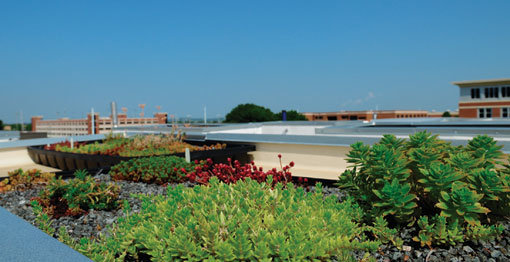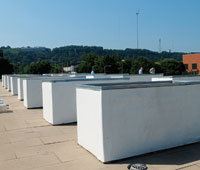Green Roof Projects Could Reduce Pollution, Power Use
By Grant Martin

A new project at UAB is sending researchers through the roof. In a pioneering test of a hot “green” technology, UAB’s facilities management department has installed 15 miniature gardens and other experimental coverings (including river rock and marble chips) atop the Chemistry Building.
The idea is to lower rooftop temperatures and therefore lessen the heat load to a building, reducing the energy needed to keep the building cool.
 |
Fifteen separate containers form miniature gardens for researchers to test the effectiveness of different roof types. |
“Green roofs are one way urban areas are combating the ‘urban heat island effect,’ where temperatures in the city run two to 10 degrees higher than in surrounding rural areas,” says Robert Peters, Ph.D., professor of environmental engineering in the UAB School of Engineering. “Many different types of existing green-roof systems, including vegetative and white reflective roofs, are being evaluated in this study and compared to traditional roofs for their effectiveness in conserving energy and sustainability.”
Civil engineering students are measuring temperatures and examining the interface between the roof insulation and building materials in each of the test beds—using sensors that record temperature data every 10 minutes.
Best Roof in the South
The researchers hope to determine the best type of roof for the Southern climate. “We’re not just looking at new construction,” Peters adds. “We also want to identify which roof is the best candidate for retrofitting existing roofs.”
This is not UAB’s first foray into green-roof technology. In 2008, the Hulsey Center was retrofitted with two separate types of green roofs. In a related project. Peters and other researchers from the Department of Civil, Construction, and Environmental Engineering; the Department of Biology; and Facilities Management have been collecting data from the roughly 30 mini-roofs set up atop the Business and Engineering Complex, which are designed to study optimal plant selection, the reduction of stormwater runoff, and the impact the roofs are having on the release of nitrates and phosphates into the environment. Biology department researchers are also studying the effect of irrigation on the survivability of rooftop plant species.
Preliminary evidence shows that the Hulsey Center’s pilot vegetated roof is already providing significant energy savings, with costs down 20 to 25 percent in the first 18 months, compared to the previous four years. “We expected the roofs to contribute to decreases, but frankly we’re surprised” at the savings, says UAB facilities energy manager Matt Winslett. “It’s really almost too good to be true.”
Click the forward and back buttons in the image below to see a slideshow of UAB's green-roof research.